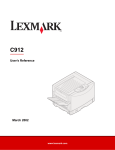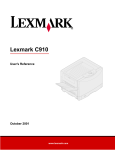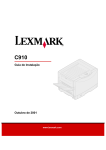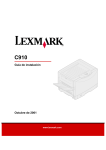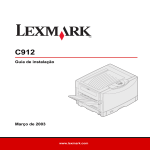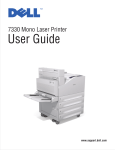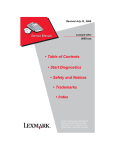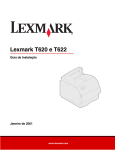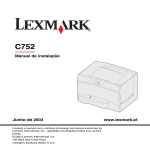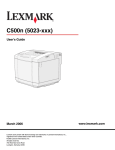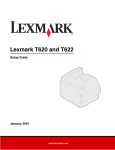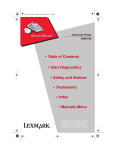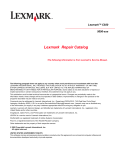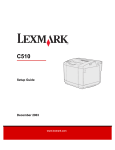Download Lexmark Optra C710 Printer User Manual
Transcript
Infoprint Color 1228 Setup Guide S510-2222-00 Infoprint Color 1228 Setup Guide S510-2222-00 Edition: October 2001 © Copyright 2001 Lexmark International, Inc. All rights reserved. UNITED STATES GOVERNMENT RESTRICTED RIGHTS This software and documentation are provided with RESTRICTED RIGHTS. Use, duplication or disclosure by the Government is subject to restrictions as set forth in subparagraph (c)(1)(ii) of the Rights in Technical Data and Computer Software clause at DFARS 252.227-7013 and in applicable FAR provisions: Lexmark International, Inc., Lexington, KY 40550. FCC emissions information This color laser printer has been tested and found to comply with the limits for a Class A digital device, pursuant to Part 15 of the FCC Rules. Operation is subject to the following two conditions: (1) this device may not cause harmful interference, and (2) this device must accept any interference received, including interference that may cause undesired operation. Refer to the Publications CD for additional details. Any questions on this statement should be directed to: Director of Lab Operations Lexmark International, Inc. 740 West New Circle Road Lexington, KY 40550 (859) 232-3000 Safety information • • • • • If your product is NOT marked with this symbol , it MUST be connected to an electrical outlet that is properly grounded. The power cord must be connected to an electrical outlet that is near the product and easily accessible. Refer service or repairs, other than those described in the operating instructions, to a professional service person. This product is designed, tested, and approved to meet strict global safety standards with the use of specific Lexmark components. The safety features of some parts may not always be obvious. Lexmark is not responsible for the use of other replacement parts. Your product uses a printing process that heats the print media, and the heat may cause the media to release emissions. You must understand the section in your operating instructions that discusses the guidelines for selecting print media to avoid the possibility of harmful emissions. Conventions It may help you to recognize the caution and warning conventions used in this book. These appear in the left column for easy reference. CAUTION! A caution identifies something that could cause you harm. Warning! A warning identifies something that could damage your printer hardware or software. Table of contents Introduction . . . . . . . . . . . . . . . . . . . . . . . . . . . . . . . . . . . . . . . v About your printer . . . . . . . . . . . . . . . . . . . . . . . . . . . . . . . . . . . v Other sources of information . . . . . . . . . . . . . . . . . . . . . . . . . vi Step 1: Unpack your printer . . . . . . . . . . . . . . . . . . . . . . . . . 1 Step 2: Select a location for your printer . . . . . . . . . . . . . . 3 Considering environmental issues . . . . . . . . . . . . . . . . . . . . . .3 Allowing enough space . . . . . . . . . . . . . . . . . . . . . . . . . . . . . . .4 Step 3: Set up the printer and paper handling options . . . 8 Installing the printer base or cabinet . . . . . . . . . . . . . . . . . . . . .9 Installing a 550-sheet drawer . . . . . . . . . . . . . . . . . . . . . . . . .10 Positioning the printer . . . . . . . . . . . . . . . . . . . . . . . . . . . . . . .11 Installing an optional duplex unit . . . . . . . . . . . . . . . . . . . . . . .12 Installing an optional high-capacity feeder . . . . . . . . . . . . . . .15 Attaching the paper tray labels . . . . . . . . . . . . . . . . . . . . . . . .23 Step 4: Install memory and option cards . . . . . . . . . . . . . 24 Removing the system board access cover . . . . . . . . . . . . . . .24 Installing a memory card . . . . . . . . . . . . . . . . . . . . . . . . . . . . .27 Installing a firmware card . . . . . . . . . . . . . . . . . . . . . . . . . . . .28 Installing a hard disk . . . . . . . . . . . . . . . . . . . . . . . . . . . . . . . .30 Installing an option card . . . . . . . . . . . . . . . . . . . . . . . . . . . . .31 Reinstalling the system board access cover . . . . . . . . . . . . . .34 Step 5: Attach cables . . . . . . . . . . . . . . . . . . . . . . . . . . . . . 35 Network printing . . . . . . . . . . . . . . . . . . . . . . . . . . . . . . . . . . .35 Local printing . . . . . . . . . . . . . . . . . . . . . . . . . . . . . . . . . . . . .37 Table of contents iii Step 6: Install printer supplies . . . . . . . . . . . . . . . . . . . . . . 38 Opening the top cover . . . . . . . . . . . . . . . . . . . . . . . . . . . . . .38 Installing the photodevelopers . . . . . . . . . . . . . . . . . . . . . . . .41 Installing the toner cartridges . . . . . . . . . . . . . . . . . . . . . . . . .44 Attaching the Quick Reference booklet sleeve . . . . . . . . . . . .47 Attaching an adhesive operator panel overlay . . . . . . . . . . . .48 Closing the top cover . . . . . . . . . . . . . . . . . . . . . . . . . . . . . . .49 Step 7: Load paper . . . . . . . . . . . . . . . . . . . . . . . . . . . . . . . 51 Loading the paper trays . . . . . . . . . . . . . . . . . . . . . . . . . . . . .52 Loading the multipurpose feeder . . . . . . . . . . . . . . . . . . . . . .59 Loading the high-capacity feeder . . . . . . . . . . . . . . . . . . . . . .63 Step 8: Verify printer setup . . . . . . . . . . . . . . . . . . . . . . . . 67 Turning on the printer . . . . . . . . . . . . . . . . . . . . . . . . . . . . . . .67 Printing a menu settings page . . . . . . . . . . . . . . . . . . . . . . . .68 Printing a network setup page . . . . . . . . . . . . . . . . . . . . . . . .69 Step 9: Configure for TCP/IP . . . . . . . . . . . . . . . . . . . . . . . 70 Setting the printer IP address . . . . . . . . . . . . . . . . . . . . . . . . .70 Verifying the IP settings . . . . . . . . . . . . . . . . . . . . . . . . . . . . .71 Configuring for Pull Printing . . . . . . . . . . . . . . . . . . . . . . . . . .71 Network printing . . . . . . . . . . . . . . . . . . . . . . . . . . . . . . . . . . .72 Local printing . . . . . . . . . . . . . . . . . . . . . . . . . . . . . . . . . . . . .74 Identifying printer users . . . . . . . . . . . . . . . . . . . . . . . . . . . . .77 Finding information . . . . . . . . . . . . . . . . . . . . . . . . . . . . . . . . .77 Distributing the information . . . . . . . . . . . . . . . . . . . . . . . . . . .78 Storing the Quick Reference . . . . . . . . . . . . . . . . . . . . . . . . . .78 Index . . . . . . . . . . . . . . . . . . . . . . . . . . . . . . . . . . . . . . . . . . . 79 iv Table of contents Introduction About your printer Base printer Network model Your printer is available in four models: • The base printer with 2400 IQ resolution, 64MB of standard memory, one 550-sheet tray, multipurpose feeder, and USB and parallel connectors. • Network model with 64MB of standard memory, an Ethernet 10BaseT/100BaseTx print server installed, an additional 550-sheet drawer, and USB and Ethernet connectors. • Network internet model with an ImageQuick firmware card installed. • Duplex network model with network and duplexing capabilities. To customize your printer you can purchase a variety of input options including a high-capacity feeder. If you purchased your printer as part of a multifunction device, refer to the documentation that came with the device for information about setting up components other than the printer. Network internet model Duplex network model v Other sources of information If you need more information after you have completed setup, refer to the other printer documentation. Publications CD The Publications CD provides information about loading paper, clearing error messages, ordering and replacing supplies, installing maintenance kits, and troubleshooting. It also provides general information for administrators. Quick Reference The Quick Reference provides easy access to information about loading print media, printing confidential jobs, understanding printer messages, and clearing jams. Drivers CD The drivers CD contains all the necessary printer drivers to get your printer up and running. Depending on which version of the drivers CD shipped with your printer, it may also contain MarkVision™ Professional, other printer utilities, worldwide customer support phone numbers, screen fonts, and additional documentation. vi Step 1: Unpack your printer CAUTION! The printer weighs 69.9 kg (154 Ib) and requires at least four people to lift it safely. Anytime you move or lift the printer make sure you have enough people to help you. Use the handholds on the side of the printer when lifting. Remove all items from the box except the printer. Make sure you have the following items: • Printer • Power cord Note: Leave the printer in the box until • Four toner cartridges you are ready to install memory options or place it into position. • Four photodevelopers • Setup Guide • Publications CD • Quick Reference and sleeve • Drivers CD Printer Power cord If any items are missing or damaged, refer to the place where you bought your printer. Drivers CD Publications CD Save the carton and packing material in case you need to repack the printer. Toner cartridges Photodevelopers Quick Reference and sleeve Setup Guide Unpack your printer 1 Operator panel Top cover and standard output bin Exit tray (bin 1) Front door Handholds Paper tray Paper size dial Power switch Door release latch High-capacity feeder connector Rear cover Parallel or Ethernet connector Option slot cover USB connector 2 Unpack your printer Power cord Duplex unit Handholds socket cover Familiarize yourself with the names and locations of items on the front and rear of your new printer. This will help you during printer setup. We use the same terms throughout this book and on the publications CD. Step 2: Select a location for your printer Choosing the correct location for your new printer is vital to ensuring the printer provides you with the quality of service you expect. Consider these factors when selecting a place to set up your printer: Considering environmental issues Note: Adequate ventilation is important if you expect to print high volumes of materials or print continuously. • The type of environment necessary for optimum printer performance • The amount of space required for your printer and all its options When choosing a place to set up the printer, look for: • A firm, level surface • An area that is: — — — — Well ventilated Clean, dry, and free of dust Away from direct sunlight Free of temperature or humidity extremes or fluctuations — Away from the direct airflow of heaters, air conditioners, or ventilators Select a location for your printer 3 Allowing enough space Base printer 734.9 mm (29 in.) 102 mm (5 in.) 1241.8 mm (56 in.) 4 152.1 mm (6 in.) 508 mm (26 in.) 329.5 mm (13 in.) Select a location for your printer 1178.4 mm (46.5 in.) When choosing a place to set up your printer, be sure to allow enough space for the printer and any options you may have purchased. It’s also important to allow space for proper ventilation around the printer. When selecting a location for your printer, make sure you have at least the amount of space indicated in the figure. Network and internet printers The network and internet models are configured with two 550-sheet drawers. Make sure you have at least the amount of space indicated in the figure. 869.2 mm (34.3 in.) 102 mm (5 in.) 1241.8 mm (56 in.) 152.1 mm (6 in.) 508 mm (26 in.) 329.5 mm (13 in.) 1355.8 mm (53.5 in.) Select a location for your printer 5 Duplex network printers 869.2 mm (34.3 in.) 102 mm (5 in.) 329.5 mm (13 in.) 1241.8 mm (56 in.) 6 508 mm (26 in.) 329.5 mm (13 in.) Select a location for your printer 1355.8 mm (53.5 in.) The duplex network printer is configured with two 550-sheet drawers and an internal duplex unit. Make sure you have at least the amount of space indicated in the figure. Printer with high-capacity feeder You can add a high-capacity feeder to your printer if you have a printer cabinet or if you have a printer stand with optional drawers. When attaching a high-capacity feeder, make sure you provide the additional space indicated in the figure. 1110 mm (43.8 in.) 102 mm (5 in.) 1241.8 mm (56 in.) 494.2 mm (30 in.) 508 mm (26 in.) 329.5 mm (13 in.) 17.84.1 mm (70.4 in.) Select a location for your printer 7 Step 3: Set up the printer and paper handling options Note: Be sure to set up the items in the order listed in the table. 8 Use the following table to locate the instructions you need to set up your printer and any paper handling options you may have purchased. Topic Go to page... Installing the printer base or cabinet 9 Installing a 550-sheet drawer 10 Positioning the printer 11 Installing an optional duplex unit 12 Installing an optional high-capacity feeder 15 Set up the printer and paper handling options Installing the printer base or cabinet You can purchase an optional printer cabinet or printer base. The instructions for installing the printer cabinet or printer base are the same. To install the printer cabinet: 1 Remove the printer cabinet from the box. 2 Remove all packing material from the printer cabinet. 3 Follow the instructions that came with the option to assemble or prepare the cabinet or base for installation. 4 Place the printer cabinet in the location you have chosen for your printer. Set up the printer and paper handling options 9 Installing a 550-sheet drawer Your printer supports a total of up to three optional 550-sheet drawers. 1 Unpack the 550-sheet drawer and remove any packing material. 2 Place the 550-sheet drawer on the optional printer cabinet, optional printer base, or in the location you have chosen for your printer. 3 If you have additional 550-sheet drawers: a Align the positioning posts on the lower drawer with the holes in the 550-sheet drawer. b Lower the 550-sheet drawer into place. Make sure it is seated securely on the other drawer. 4 10 Set up the printer and paper handling options Go to “Positioning the printer” on page 11. Positioning the printer CAUTION! The printer weighs 69.9 kg (154 Ib) and requires at least four people to lift it safely. Anytime you move or lift the printer make sure you have enough people to help you. Use the handholds on the side of the printer when lifting. Once you have selected a location and set up any optional 550-sheet drawers, you are ready to position the printer. 1 Have others help you lift the printer out of the box. Use the handholds on the sides of the printer. Set up the printer and paper handling options 11 2 Have three other people help you place the printer in the location you have chosen. If you are installing the printer on a 550-sheet drawer, align the positioning posts on the option with the holes in the printer. Make sure the printer is seated securely on the option. 3 Installing an optional duplex unit Remove any tape or packing material from the outside of the printer. Your printer supports an optional duplex unit that provides two-sided printing. To install the duplex unit: 12 Set up the printer and paper handling options 1 Remove the duplex unit from its packing material. 2 Remove any shipping tape and additional packing material from the duplex unit. 3 Open the duplex unit access door on the left side of the printer. 4 Align the duplex unit with the slots in the printer. 5 Slide in the duplex unit. Set up the printer and paper handling options 13 14 Set up the printer and paper handling options 6 Align the thumbscrews on the duplex unit with the holes in the printer. 7 8 Tighten the thumbscrews . Close the duplex unit door. Installing an optional high-capacity feeder Your printer supports an optional highcapacity feeder. You can load up to 3,000 sheets of paper in the highcapacity feeder. Note: You must have an optional printer cabinet or an optional printer stand with optional drawers to install a highcapacity feeder. High-capacity feeder Docking frame Interface cable Power cord Guide rail Four docking frame screws 1 Remove and unpack all items from the box. 2 Make sure you have the following items: — — — — — — — — High-capacity feeder Docking frame Guide rail Interface cable Power cord Four docking frame screws Cable holder Eight height adjustment spacers — Wrench If any items are missing or damaged, refer to the place where you bought your printer. Cable holder Eight height adjustment spacers Wrench Set up the printer and paper handling options 15 3 Make sure the printer power switch is in the Off position. 1 Remove the two side covers from the top 550-sheet drawer. Attaching the docking frame You may need to use a small flathead screwdriver to pry the covers up and outward. 16 Set up the printer and paper handling options 2 Insert two screws through the top screw holes of the docking frame and into the holes in the 550sheet drawer. 3 Use the wrench to tighten the screws. 4 Insert two screws through the bottom screw holes of the docking frame and into the holes in the printer cabinet or printer base. 5 Tighten the screws. 6 Place the wrench in the holder on the high-capacity feeder. Set up the printer and paper handling options 17 Attaching the guide rail and feeder Note: Make sure all four casters are on the guide rail. 18 Set up the printer and paper handling options 1 Align the two holes on guide rail with the studs on the docking frame. 2 Slide the guide rail down until it is fully seated on the docking rail. 3 Place the high-capacity feeder on the guide rail. 4 Roll the high-capacity feeder toward the printer and check the alignment of the pins with the holes in the docking frame. If the pins do not align with the holes in the docking frame, see “Installing height adjustment spacers” on page 21. 5 Roll the high-capacity feeder toward the printer until the feeder locks to the docking frame. When the feeder is in the correct position, you hear a click when it locks. Set up the printer and paper handling options 19 CAUTION! Do not install the highcapacity feeder power cord at this time. 20 Set up the printer and paper handling options 6 Attach the interface cable to the back of the printer and tighten the thumbscrews. 7 Attach the interface cable to the side of the high-capacity feeder and tighten the thumbscrews. 8 Insert the point on the cable holder into the hole on the back of the top optional drawer. 9 Place the high-capacity feeder cable into the holder. 10 Installing height adjustment spacers Close the cable holder. If the pins on the high-capacity feeder did not align with the holes in the docking frame you can adjust the height of the feeder. You can either remove the factory installed spacer or add two spacers between each caster and the bottom of the high-capacity feeder. Use the following steps to add or remove spacers. 1 Determine the height difference between high-capacity feeder alignment pins and the docking frame. Set up the printer and paper handling options 21 2 Place the high-capacity feeder on the floor or adequate work surface. 3 Remove the four screws securing one of the casters to the highcapacity feeder. 4 Add or remove spacers. To add spacers: a Insert the four screws through the caster. b Place the spacers on the screws. c Align and insert the screws into the screw holes on the high-capacity feeder. To remove the factory installed spacer: a Remove the spacer from the top of the caster. b Insert the four screws through the caster. c Align and insert the screws into the screw holes on the high-capacity feeder. 22 Set up the printer and paper handling options 5 Tighten the four screws to secure the caster to the high-capacity feeder. 6 Repeat steps 3 through 5 to add or remove spacers on the remaining three casters. 7 Return to step 5 on page 19. Attaching the paper tray labels Paper tray labels are included with each paper tray option. Use the labels to indicate the tray number and help identify paper jams and change paper tray menu options. Refer to the illustrations to determine where to place the tray numbers for your printer configuration. Set up the printer and paper handling options 23 Step 4: Install memory and option cards You can customize your printer memory capacity and connectivity by adding optional cards or hard disk. Removing the system board access cover CAUTION! If you are installing memory or option cards after initial printer setup, turn the printer off and unplug the power cord. If you have any other devices connected to the printer, turn them off as well and unplug any cables going to the printer. Rear cover 24 Install memory and option cards You must remove the system board cover to install memory cards, a firmware card, a hard disk, or an option card. You need a number 2 Phillips screwdriver to remove the system board cover. 1 Loosen the eight screws on the system board cover. Do not remove the screws completely. 2 Slide the cover up and away from the printer. Screws Screws Install memory and option cards 25 3 Use the illustration to locate the connector for the card you want to install. 4 Use the following table to locate the instructions you need. Memory and flash memory card connectors Option card connector Parallel connector Ethernet connector USB connector Optional ImageQuick firmware card Optional hard disk Option card cover 26 To install a... Go to page... Memory card 27 Firmware card 28 Hard disk 30 Option card 31 Install memory and option cards Installing a memory card Note: Memory options designed for other printers may not work with your new printer. Warning! Printer memory and flash memory cards are easily damaged by static electricity. Touch something metal such as the printer frame before you touch a memory card. Complete the following instructions to install either a printer memory card or a flash memory card. Memory cards must have 168-pin connectors. The system board has three connectors for optional memory cards. You can install any combination of printer memory and flash memory cards in the connectors. However, the printer only recognizes one flash memory card at a time. 1 Remove the system board access cover (see page 24). 2 Push open the latches on both ends of the memory connector you want to use. 3 Unpack the memory card. Avoid touching the connection points along the edge of the card. Save the packaging. Install memory and option cards 27 4 Align the notches on the bottom of the card with the notches on the connector. 5 Push the memory card firmly into the connector until the latches on either end of the connector snap into place. It may require some force to fully seat the card. 6 Installing a firmware card Make sure each latch fits over the notch on the end of the card. Follow the instructions in this section to install a firmware card. If you have a network internet model, an ImageQuick™ firmware card is already installed. Note: Firmware cards designed for other printers may not work with your new printer. If an option card has been installed, you need to remove the option card before installing the firmware card. 1 28 Install memory and option cards Remove the system board access cover (see page 24). Warning! Firmware cards are easily damaged by static electricity. Touch something metal such as the printer frame before you touch a card. 2 Alignment pins Unpack the firmware card. Avoid touching the metal pins on the bottom of the card. Save the packaging. System board holes 3 Holding the card by its sides, align the pins on the card with the holes on the system board. 4 Push the firmware card firmly into place. The entire length of the connector on the firmware card must touch the system board. Be careful not to damage the connectors. Install memory and option cards 29 Installing a hard disk Warning! Hard disks are easily damaged by static electricity. Touch something metal such as the printer frame before you touch the hard disk. 30 Install memory and option cards Follow the instructions in this section to install an optional hard disk. If an option card has been installed, you need to remove the option card before installing the hard disk. 1 Remove the system board access cover (see page 24). 2 Align and press the ribbon cable connector into the connector on the system board. 3 Installing an option card Flip the hard disk over, and then press the three posts on the mounting plate into the holes on the system board. The hard disk snaps into place. Your printer has one expansion card slot that supports a number of option cards. The following table describes their function. Card Function MarkNet™ internal print server Adds an Ethernet or Token-Ring port to connect your printer to a network. Install a MarkNet N2501e or N2401e internal print server if you received either of these cards as part of a multifunction printer upgrade. USB/Parallel 1284-C Interface Card Adds a Universal Serial Bus (USB) port or a parallel port. Coax/Twinax Adapter for SCS Adds a coaxial/twinaxial port. Tri-Port Adapter Adds LocalTalk, serial, and infrared ports. For details on setting up and using the Tri-Port Adapter, refer to the documentation that shipped with the card. Infrared Adapter Adds infrared functionality. Install memory and option cards 31 Note: The network, internet network, and duplex network printers ship with an Ethernet print server already installed. You need a small Phillips screwdriver to install these options. 1 Remove the system board access cover (see page 24). 2 Remove the screw from the metal plate that covers the connector slot, and then lift the plate off. Save the screw. Warning! Option cards are easily damaged by static electricity. Touch something metal such as the printer frame before you touch an option card. 32 Install memory and option cards 3 Unpack the option card. Save the packing materials. 4 Align the connector on the option card with the connector on the system board. The cable connectors on the side of the option card must fit through the connector slot. 5 Push the option card firmly into the option card connector. 6 Secure the card to the system board with the screws. Install memory and option cards 33 Reinstalling the system board access cover Screw slot 34 Install memory and option cards After you have finished installing cards on the printer system board, you must reinstall the system board access cover. 1 Align the holes on the access cover with the screws on the printer as shown. 2 Place the cover against the printer and slide it down. 3 Tighten the eight screws. Step 5: Attach cables Your printer can be attached to a network or locally (directly to a computer). Network printing You can attach your printer to a network using standard network cables. A 10BaseT/100BaseTX Fast Ethernet port is standard on the network, internet network, and duplex network printers. You can add a Token-Ring or 10Base2 Ethernet port to any printer model by installing an optional internal print server. To attach the printer to a network: 1 2 Make sure the printer is turned off and unplugged. Connect the printer to a LAN drop or hub using standard cabling that is compatible with your network: — Token-Ring, Ethernet 10BaseT, or Ethernet 100BaseTX networks (Category 5) use an RJ-45 connector Attach cables 35 — Token-Ring networks (Shielded Twisted Pair) use a DB9 connector — Ethernet 10Base2 networks (Thin Coax) use a BNC T-connector The printer automatically adjusts itself for the network speed. 36 Attach cables Local printing Note: All Windows operating systems support parallel connections. However, only the Windows 98, Windows Me, and Windows 2000 operating systems support USB connections. Some UNIX, Linux, and Macintosh computers also support USB connections. Refer to your computer documentation to see if your system supports USB. You can attach your printer locally using either a USB port or a parallel port. • A USB port requires a USB printer cable. • A parallel port requires an IEEE-1284 compliant parallel cable. If you install an optional USB/Parallel Interface Card to the network, internet network, or duplex network printer, you need a 1284 A-C parallel cable, or a USB cable. If you have installed an optional Tri-Port Adapter, you can locally attach the printer with a serial cable. For details on LocalTalk or infrared connections, refer to the documentation that shipped with the Tri-Port Adapter. To attach the printer to a computer: 1 Make sure the printer, computer, and any other attached devices are turned off and unplugged. 2 Connect the printer to the computer using a parallel or USB cable. — Use an IEEE-1284 compliant parallel cable to ensure that you can access all of your printer functions. — Be sure to match the USB symbol on the cable to the USB symbol on the printer. Attach cables 37 Step 6: Install printer supplies Opening the top cover To access the printer supplies you must open the top cover. To open the top cover: 38 Install printer supplies 1 Remove any shipping tape and packing material from the front of the printer. 2 Open the front door. 3 Rotate the top cover locking lever to the left. 4 Place both hands on the lifting points and squeeze the right top cover latch. Note: The top cover will open very quickly, keep both hands on the top cover when opening. Right top cover latch Install printer supplies 39 5 6 40 Install printer supplies Lift the top cover until it stops. Remove any shipping tape and yellow packing material from inside the printer. Installing the photodevelopers Your printer ships with four color-coded photodevelopers which you must place inside the top cover . Each photodeveloper has its own color-coded position inside the printer. Warning! Do not touch, drop, or place anything on the transfer belt. Touching the surface of the transfer belt or placing items on it may damage it. 1 Lift and remove the four shipping spacers from the transfer belt. 2 Remove any shipping tape and packing material from inside the printer. Transfer belt Install printer supplies 41 3 Remove one of the photodevelopers from its packing material. You can install the photodevelopers in any order. However, it may be easier to install them from left to right: black, yellow, cyan, and magenta. 4 Remove the tape from the photodeveloper. The photodeveloper has a cover over the green glass tube. Do not touch the glass. Touching the glass may damage it and reduce print quality. Do not remove the cover until you begin installing the photodeveloper. 5 42 Install printer supplies Align the photodeveloper with the slot in the printer as shown. 6 While holding the photodeveloper with your left hand and the photodeveloper cover with your right hand, slide the photodeveloper in until the unit is fully seated. As the photodeveloper slides in, remove the photodeveloper cover. 7 Repeat steps 3 through 6 to install the remaining photodevelopers. Install printer supplies 43 Installing the toner cartridges Your printer ships with four color-coded starter toner cartridges. Starter toner cartridges have a yield of up to 8,000 pages. You must install the toner cartridges inside the top cover of the printer. Each cartridge has its own color-coded position. Note: Use a brush or cold water to remove any toner that has soiled clothing. 1 You can install the cartridges in any order. However, it may be easier to install them from left to right: black, yellow, cyan, and magenta. Waste toner arm 2 44 Install printer supplies Remove one of the toner cartridges from its packing material. Gently shake the toner cartridge to distribute the toner evenly. 3 Remove the shipping tape and any additional packing material. 4 Align the toner cartridge with its slot in the printer. The toner cartridge is placed to the right of the corresponding colored label. Colored label Install printer supplies 45 46 Install printer supplies 5 Slide the toner cartridge in until the cartridge is fully seated. 6 Push the waste toner arm onto the photodeveloper until it snaps into place. 7 Repeat steps 2 through 6 to install the remaining toner cartridges. Attaching the Quick Reference booklet sleeve The adhesive sleeve that came with your printer is a handy place to store your Quick Reference. 1 Remove the protective paper from the back of the Quick Reference pouch. 2 Firmly press the adhesive-backed sleeve onto the area inside the front door. Install printer supplies 47 Attaching an adhesive operator panel overlay If English is not your preferred language attach the overlay that has the appropriately translated button names: 1 Locate the adhesive overlay packaged with your printer. 2 3 Peel the backing off the overlay. 4 Peel the covering away from the overlay. Align the holes in the overlay with the buttons on the operator panel, and then press it into place. Refer to the publications CD for instructions on changing the language of the text displayed on the operator panel. 48 Install printer supplies Closing the top cover CAUTION! Before closing the top cover, make sure the area under the cover is free of hands, clothing, and other items. 1 Place both hands on the top cover as shown. 2 Press down firmly until the top cover clicks into place. Install printer supplies 49 3 Rotate the top cover locking lever to the right. If you cannot rotate the locking lever, the cover is not fully closed. a Place both hands on the lifting points and squeeze the right top cover latch. b Lift the top cover. c Press down firmly until the top cover clicks into place. 4 50 Install printer supplies Close the front door. Step 7: Load paper The following table lists page numbers where you can find loading instructions for the standard and optional trays, as well as for the multipurpose feeder. Go to page... Source Paper sizes Paper types Capacity Tray 1 Letter, A4, Legal, Tabloid1, A3, B4 Paper, glossy paper • 550 sheets of 20 lb paper • 130 sheets of glossy paper 52 Trays 2-4 Letter, A4, Legal, Tabloid,1 A3, B4, Universal1 Paper • 550 sheets of 20 lb paper 52 Heavy media tray Letter, A4, Legal, Tabloid1, A3, Universal1 Paper, glossy paper, transparencies, labels, card stock • 150 transparencies • 250 sheets of labels or card stock • 500 sheets of glossy paper 52 Multipurpose feeder Letter, A4, A5, Legal, Tabloid2, A3, Executive, B4, JIS B5, Universal1 Paper, glossy paper, transparencies, labels, card stock • • • • • 59 7¾, 9, 10, DL, C4, C5, B5, other3 Envelopes 10 envelopes Letter, A4 Paper 3000 sheets of 20 lb paper High capacity feeder 1 Tabloid paper is 278.8 x 430.8 mm (11 x 17 in.) 2 Universal setting lets you select the following custom sizes: 100 sheets of 20 lb paper 50 sheets of glossy paper 50 transparencies 30 sheets of labels 50 sheets card stock 63 – 139.7 x 210 mm to 215.9 x 355.6 mm (5.5 x 8.27 to 8.5 x 14 in.), – 69.85 x 127 mm to 229 x 355.6 mm (2.75 x 5 to 9.01 x 14 in.) – 148 x 182 mm to 215.9 x 355.6 mm (5.83 x 7.17 to 8.5 x 14 in.) 3 You can use other envelope sizes if they are: 98.4 x 162 mm to 176 x 250 mm (3.87 x 6.38 to 6.93 x 9.84 in.) Load paper 51 Your printer supports a wide variety of paper types, sizes, and weights. The standard tray (tray 1) and optional trays 2, 3, and 4 are marked with stack height letters A, B, and C. The optional heavy media tray is marked with stack height letters D, E, and F. The following table lists recommended media, weights, and the stack height guide to use when loading the paper trays. Stack height letter Recommended media A Lexmark Glossy Paper*: Letter (P/N 12A5950), A4 (P/N 12A5951) B 11x17, Legal, B4, A3 (90–105 g/m2, 24–28 lb bond) C Letter, A4 (60–105 g/m2, 16–28 lb bond) 11x17, Legal, B4, A3 (60 - 90 g/m2, 16 - 24 lb bond) D Lexmark Transparency**: Letter (P/N 12A5940), A4 (P/N 12A5941) E Lexmark Glossy Paper*: Letter (P/N 12A5950), A4 (P/N 12A5951) Paper Labels: Letter, A4 (up to 180 g/m2, 48 lb bond) F Letter, A4 (105–128 g/m2, 28–34 lb bond) * Lexmark Glossy Paper is 120 g/m2, 80 lb. book, 32 lb bond. ** Lexmark Transparency weight is 120 g/m2. Loading the paper trays Each paper tray provides an input of 550 sheets of paper. Note: If you have an optional heavy Follow these instructions to load paper in all the paper trays. media paper tray, make sure you review the heavy media tray section in the table on page 51 and follow the heavy media tray instructions on page 57. 52 Load paper 1 Pull the paper tray out until it stops. 2 Press the metal plate down until it locks. Load paper 53 Note: The position of the left paper guide tells the printer the size of the paper in the tray. If the left paper guide is in the wrong position, you may experience paper feeding problems or incorrect page formatting. 3 Squeeze the left guide and slide it to the position for the size paper you are loading. 4 Release the paper guide. 5 Flex the sheets back and forth to loosen them, and then fan them. Do not fold or crease the paper. Straighten the edges of the stack on a level surface. 54 Load paper Note: Do not exceed the maximum stack height. Overfilling the tray may cause jams. 6 Place the paper in the tray, print side down. 7 Squeeze the front paper guide lever and slide the guide until it lightly touches the stack of paper. Load paper 55 56 Load paper 8 Rotate the paper size dial until the size of the paper in the tray is indicated. 9 Push the tray completely in the printer. Using the heavy media tray Note: Using the heavy media tray with lighter weight paper such as 16–26 lb plain paper may cause jams. The optional heavy media tray replaces tray 1. The heavy media tray is specially designed for use with heavier plain paper, transparencies, labels, and card stock. For instructions on installing the heavy media tray, refer to your publications CD. When the heavy media tray is installed, it turns the auto size sensing off. You must set the operator panel to the size and type of media you have placed in the tray. Set the paper size Note: For more information about using 1 Follow the instructions for “Loading the paper trays” on page 52 to place your print media in the heavy media paper tray. 2 Press Menu until you see Paper Menu, and then press Select. 3 Press Menu until you see Paper Size, and then press Select. 4 Press Menu until you see Tray 1 Size, and then press Select. 5 Press Menu until the size paper you placed into the tray appears, and then press Select. the operator panel and changing menu settings, refer to the publications CD. PAPER MENU PAPER SIZE 1 Menu 2 Select Go 3 Return 5 Stop 4 6 Load paper 57 Set the paper type 1 Paper Menu appears on the first line and Paper Size appears on the second line. PAPER MENU PAPER TYPE 1 Menu 2 Select Go 3 Return 5 Stop 4 2 Press Menu until you see Paper Type, and then press Select. 3 Press Menu until you see Tray 1 Type, and then press Select. 4 Press Menu until you see Custom Type 1, and then press Select. 5 Press Return once. 6 Tray 1 Type Custom Type 1 1 Menu 2 Select Go 3 Return 5 Stop 4 6 Paper Menu appears on the first line and Paper Type appears on the second line. PAPER MENU PAPER TYPE 1 Menu 2 Press Return once. Select Go 3 Return 5 Stop 4 6 Press Menu until you see Custom Types, and then press Select. 6 7 Press Menu until you see Custom Type 1, and then press Select. 8 Press Menu until you see the type of media you loaded in the heavy media tray, and then press Select. 9 Press Go. Ready is displayed. 58 Load paper Loading the multipurpose feeder The multipurpose feeder provides an additional input of 100 sheets of paper. You can use the multipurpose feeder one of two ways: • Paper tray—Load plain paper, glossy paper, labels, card stock, or other print media in the feeder with the intention of leaving the media in the feeder. • Manual bypass feeder—Send a print job to the feeder while specifying the type and size of media from your computer. The printer then prompts you to load the appropriate print media before it prints. To load the multipurpose feeder: 1 Open the multipurpose feeder. Load paper 59 Note: The guides are interconnected, when you move one, they both move together. 60 Load paper 2 Slide the paper guides to the correct position for the size paper you are loading. 3 Press the paper feed plate down until it locks into place. 4 Flex the sheets back and forth to loosen them, and then fan them. Do not fold or crease the paper. Straighten the edges of the stack on a level surface. Note: Do not exceed the maximum stack height. Overfilling the feeder may cause jams. 5 Place the paper print side up between the paper guides. Load paper 61 6 Move the SET button to the left to unlock the tray. The multipurpose tray can be closed by lifting it. Set button 62 Load paper Loading the highcapacity feeder Note: Do not load any print media other The optional high-capacity feeder provides an additional input of 3,000 sheets of paper. To load the high-capacity feeder: than paper in the high-capacity feeder. 1 Open the high-capacity feeder top cover. The paper guides are set at the factory and may already be configured for your size paper. 2 Inspect the position of the paper guides. If the paper guides are correctly set for the size paper you are loading, go to step 6 on page 65, if not continue with step 3 on page 64. Load paper 63 Note: The high-capacity feeder must be properly adjusted for A4 or Letter size paper. If the paper guides are in the wrong position, you may experience paper feeding problems. 64 Load paper 3 Loosen the left and right paper guide thumbscrews. 4 Slide the guides left or right to the correct position for the size paper you are loading (A4 or Letter). 5 Tighten the left and right paper guide thumbscrews. 6 Flex the sheets back and forth to loosen them, and then fan them. Do not fold or crease the paper. Straighten the edges of the stack on a level surface. Note: Do not exceed the maximum stack height. Overfilling the tray may cause paper jams. 7 Place the paper against the paper guides, with the print side up. Load paper 65 Note: If there is only a partial stack of paper in the tray, the paper low sensor will not allow the tray to go down. Add more paper to lower the tray. 8 Press the Paper Tray button. The paper tray lowers so you can load another 500 sheets of paper. 9 Place the paper against the paper guides, with the print side up. 10 Repeat step 8 and step 9 until you have filled the tray or loaded the desired quantity. 11 Close the high-capacity feeder top cover. Make sure the high-capacity feeder is pushed completely against the printer. 66 Load paper Step 8: Verify printer setup Turning on the printer Note: To prevent an electrical overload, plug your printer into a well-grounded outlet on a nonground fault interrupter (GFI) circuit. 1 Plug one end of the power cord into the socket on the side of the printer and the other end into a properly grounded outlet. Verify printer setup 67 2 Plug one end of the high-capacity feeder power cord into the socket on the side of the high-capacity feeder and the other end into a properly grounded outlet. 3 Turn on the printer. If the printer is attached locally (directly to a computer), leave the computer and any other attached devices turned off. You will turn these on in a later step. The message Performing Self Test appears on the display while the printer warms up. After the internal tests complete, the Ready message indicates the printer is ready to receive jobs. If you see a message other than Ready , refer to your quick reference booklet or the publications CD for instructions on clearing the message. Click Printing, and then Understanding printer messages. 4 If you attached your printer to a network, continue with “Printing a network setup page” on page 69. Otherwise, go on to “Printing a menu settings page” on page 68. Printing a menu settings page Print the menu settings page to review the default printer settings and to verify that printer options are installed correctly. Note: For more information 1 about using the operator panel and changing menu settings, refer to the publications CD. Press Menu until you see Utilities Menu, and then press Select. 2 Press Menu until you see Print Menus, and then press Select to print the page. The message Printing Menus is displayed. 3 UTILITIES MENU 1 Menu 2 Select Go 68 3 Return 5 Verify printer setup Stop Verify the options you installed are correctly listed under “Installed Features.” If an option you installed is not listed, turn the printer off, unplug the power cord, and reinstall the option. 4 4 Verify the amount of memory installed is correctly listed under “Printer Information.” 5 Verify the paper trays are configured for the sizes and types of paper you loaded. 6 Printing a network setup page If the printer is attached to a network, print a network setup page to verify the network connection. This page also provides important information that helps you configure for network printing. Note: If an optional MarkNet 1 card is installed in slot 1, you see Print Net1 Setup on the display. Press Menu until you see Utilities Menu, and then press Select. 2 Press Menu until you see Print Net Setup, and then press Select. The network setup page prints and the printer returns to Ready status. 3 Check the first section on the network setup page and confirm that Status is “Connected.” UTILITIES MENU 1 Menu 2 Select 3 Return If Status is “Not Connected,” your LAN drop may not be active or your network cable may be malfunctioning. Consult your network support person, and then print another network setup page to verify that you are connected to your network. 4 Save the network setup page for later use. Go 5 Stop 6 What do I do next? Task Go to page… Configure for TCP/IP 70 Install printer drivers 72 Verify printer setup 69 Step 9: Configure for TCP/IP If you have TCP/IP available on your network, we recommend that you assign an IP address to the printer. Setting the printer IP address Note: You can find instructions for other methods of setting the IP address in the online documentation on the drivers CD that shipped with your printer. Launch the CD, click View Documentation, and then click Network Printer Install. 70 Configure for TCP/IP If your network is using DHCP, an IP address is automatically assigned after you connect the network cable to the printer. 1 Look for the address under the TCP/IP heading on the network setup page you printed in “Printing a network setup page” on page 69. 2 Go to “Verifying the IP settings” on page 71 and begin with step 2. If your network is not using DHCP, you must manually assign an IP address to the printer. One of the easiest ways is to use the operator panel: 1 Press Menu until you see Network Menu, and then press Select. 2 Press Menu until you see Standard Network, and then press Select. Standard Network appears if you purchased a printer with a network port on the printer system board. If you have an optional MarkNet card installed, you see Network Option 1. 3 Press Menu until you see Std Net Setup or Network 1 Setup, and then press Select. 4 5 Press Menu until you see TCP/IP, and then press Select. Press Menu until you see Set IP Address, and then press Select. 6 Change the address by pressing Menu to increase or decrease each number. Press Select to move to the next segment. Press Select when you are finished. The message Saved appears briefly. Verifying the IP settings 7 Press Menu until you see Set IP Netmask, and then press Select. 8 9 Repeat step 6 to set the IP Netmask. 10 11 Repeat step 6 to set the IP Gateway. 1 Press Menu until you see Set IP Gateway, and then press Select. When you are finished, press Go to return the printer to the Ready state. Print another network setup page. Look under the “TCP/IP” heading and make sure the IP address, netmask, and gateway are what you want. See “Printing a network setup page” on page 69 if you need help. Note: On Windows computers, click Start Programs Command Prompt. 2 Ping the printer and verify that it responds. For example, at a command prompt on a network computer type “ping” followed by the new printer IP address: ping xxx.xxx.xxx.xx If the printer is active on the network, you will receive a reply. Configuring for Pull Printing If your printer has an optional ImageQuick firmware card installed, it can be configured for Pull Printing once an IP address has been assigned. For detailed configuration instructions, refer to the CD that shipped with the ImageQuick card. Configure for TCP/IP 71 Step 10: Install printer drivers vers A printer driver is software that lets your computer communicate with your printer. The following table is a quick guide to finding the specific installation instructions you need. Type of printer installation Network environment or operating system Go to page Network Windows 95/98/Me, Windows NT 4.0, Windows 2000 72 (Ethernet or Token-Ring connections) Macintosh 73 Local Windows 95/98/Me, Windows NT 4.0, Windows 2000 74 (parallel or USB connections) Macintosh 75 Network printing Windows The following instructions explain how to install printer drivers on printers attached to a network. In Windows network environments, your printer can be configured for direct printing or for shared printing. Supported network printer ports • • 72 Install printer drivers Microsoft IP port (Windows NT 4.0 and Windows 2000) Network port (Windows 95/98/Me, Windows NT 4.0, and Windows 2000) Supported printer drivers Note: Using the color laser custom printer driver and a network port provides enhanced functionality, such as printer status alerts. • • Windows system printer driver Color laser custom printer driver System drivers are built into Windows operating systems. Custom drivers are available on the drivers CD. Supported printing methods • • Direct IP printing—when you just want to print directly to a printer on your network Shared printing (point and print, peer-to-peer)—when you need to centrally manage network printers You can find detailed information about using each of these printing methods on the drivers CD. Click View Documentation and look for information about network printer installation. Creating ports and installing drivers Read the detailed instructions on the drivers CD. Click View Documentation and look for information about network printer installation for your specific Windows environment. If you choose to install without using the instructions on the drivers CD, you need a basic understanding of network printing on TCP/IP networks, installing printer drivers, and the process involved in creating new network ports. Macintosh Note: A PostScript Product Description (PPD) file provides detailed information about the capabilities of a printer to UNIX or Macintosh drivers or applications. Your printer connects automatically to AppleTalk networks and becomes readily visible to other network clients. You must create a printer object (icon) on the desktop of each network client using the LaserWriter 8 printer driver and the printer’s PPD file. Specific information about installing the printer on your AppleTalk network can be found in the online documentation on the drivers CD that shipped with your printer. Depending upon which version of the drivers CD shipped with your printer, you may also find this software on the drivers CD. Launch the Install printer drivers 73 PPD Installer and follow the instructions to install the PPDs. Send a test print job when you have finished. Other network environments Local printing Windows Contact your point of purchase to obtain information about support for other network environments. In order to print, you must install a printer driver on the computer attached to the printer. Not all Windows operating systems support all types of connections. In addition to the following information, you may need to refer to the documentation that shipped with your computer and your Windows software. Installation instructions Read the detailed online instructions on the drivers CD. Click View Documentation and look for information about local printer installation. Detailed instructions are provided for parallel and USB connections. Supported connections Parallel or USB refers to the type of printer cable you used in “Attach cables” on page 35 to attach the printer to your computer. • Parallel (works with Windows 95/98/Me, Windows NT 4.0, and Windows 2000) • USB (works with Windows 98/Me and Windows 2000 only) Supported printer drivers Note: Using the printer’s custom printer driver provides enhanced functionality, such as printer status alerts. 74 Install printer drivers • • Windows system printer driver The printer’s custom printer driver System drivers are built into Windows operating systems. Custom drivers are available on the drivers CD. Macintosh You must install the printer’s PPD and use it with the LaserWriter 8 printer driver or the Adobe PostScript driver. You can find the printer’s PPD and specific information about local printer installation on Macintosh computers on the drivers CD that shipped with your printer. Click View Documentation and look for information about local printer installation. After the printer is installed, print a test page to verify your printer is correctly set up. Install printer drivers 75 Step 11: Distribute information to users Identifying printer users Several types of users may need access to the information stored on the Publications CD. These include: • • • • Finding information Users sending print jobs Network printer administrators Help desk personnel Information Technology support staff Launch the CD and browse the contents to see a complete list of the available information. If you have a version of Acrobat capable of full text searching, we have created catalog entries to help you find the information you need. The type of helpful information provided on the Publications CD includes: • • • • • • Tips for successful printing Ways to improve print quality Information about using the operator panel Instructions for replacing print cartridges and other supply items Solutions to common printing problems Instructions for clearing jams Distribute information to users 77 Distributing the information You can give users access to the information on the publications CD in several ways: • Give the publications CD to a system administrator or the Help desk. • Copy the entire contents of the CD (or just specific topics) to a shared network drive or Intranet site. Each topic on the publications CD is a separate PDF. Launch the CD, click Other resources, and then click File locations. This will provide a brief overview of each PDF file. • Storing the Quick Reference Congratulations! 78 Print the information on the publications CD and store it near the printer for easy access. For printing instructions, launch the CD, and then click Navigation or Print as Book from the Home page. In addition to the Publications CD, your printer shipped with a Quick Reference. We recommend that you store this booklet in the convenient sleeve. The sleeve should be attached inside the front door of the printer. You are now ready to use your new printer. Save this book if you anticipate purchasing or installing printer options in the future. Distribute information to users Index A accessing supplies 38 attaching 550-sheet drawers 10 BNC T-connector 36 DB9 connector 36 duplex unit 12 high-capacity feeder 15 memory cards 27 operator panel overlay 48 option cards 31 parallel cable 37 print server 31 Quick Reference sleeve 47 RJ-45 connector 35 USB cable 37 card stock 51 CD drivers vi publications vi Coax/Twinax Adapter for SCS 31 D dpi v drivers 72 drivers CD vi duplex network (dn) 6 duplex unit, installing 12 E environmental issues 3 exit tray 2 B base printer 4 bin 1 2 C cables Ethernet 35, 36 parallel 37 power 67 Token-Ring 35, 36 USB 37 F FCC emissions information ii firmware card, installing 28 flash memory, installing 27 H hard disk 30 heavy media paper tray 57 high-capacity feeder 15 Index 79 I M ImageQuick 71 Infrared Adapter 31 installing Coax/Twinax Adapter 31 firmware card 28 flash memory 27 hard disk with adapter card 31 internal print server 31 MarkNet print server 31 memory cards 27 option cards 31 parallel interface card 31 photodevelopers 41 print servers 31 printer drivers 72 printer memory 27 supplies 38 toner cartridges 44 Tri-Port Adapter 31 USB/Parallel Interface Card 31 internal print server 31 introduction v IP address, setting 70 IP settings, verifying 71 Macintosh 73 MarkNet internal print servers 31 maximum stack height 550-sheet trays 55 high-capacity feeder 65 multipurpose feeder 61 memory cards flash 27 installing 27 printer 27 menu settings page 68 L labels paper tray 23 printing 51 Linux 74 loading high capacity feeder 63 multipurpose feeder 59 paper trays 52 local printing cables 37 drivers 74 LocalTalk network port on Tri-Port adapter 31 80 Index N NetWare 74 network printer 5 printer location 5 network printing cables 35 drivers 72 network setup page 69 O operator panel 69 operator panel overlay, attaching 48 option cards Coax/Twinax Adapter for SCS 31 Infrared Adapter 31 installing 31 internal print server 31 Tri-Port Adapter 31 USB/Parallel Interface Card 31 options heavy media tray 57 interface cards 31 internal print server 31 memory 27 paper handling 8 printer stand 9 output bins bin 1 2 standard 2 P S paper loading 51 sizes 51 types 51 paper handling 8 paper size, setting 57 paper tray, heavy media 57 paper type, setting 58 parallel cable 37 photodevelopers, installing 41 print media 51 print server installed in network models v installing 31 printer base 9 cabinet 9 lifting 11 memory v, 27 models v turning the power on 67 unpacking 1 printer drivers 72 printer location 3, 4, 5, 6, 7 printer view, front and rear 2 printer with high-capacity feeder 7 publications CD distributing 78 information vi Pull Printing 71 safety information located on inside front cover setting paper size 57 paper type 58 sources of information vi space requirements 4, 5, 6, 7 stack height, maximum 550-sheet trays 55 high-capacity feeder 65 multipurpose feeder 61 system board, accessing 24 Q Quick Reference attaching booklet sleeve 47 booklet information vi, 78 R T TCP/IP 70 toner cartridges, installing 44 top cover closing 49 opening 38 transparencies 51 tray, exit 2 Tri-Port Adapter 31 turning on the printer 67 U UNIX 74 unpacking high-capacity feeder 15 memory cards 27 option cards 32 printer 1 USB 37 USB/Parallel Interface Card 31 W Windows 72, 74, 75, 76 resolution v Index 81 Readers’ Comments — We’d Like to Hear from You Infoprint Color 1228 Setup Guide Publication No. S510-2222-00 Overall, how satisfied are you with the information in this book? Very Satisfied Satisfied Neutral Dissatisfied Very Dissatisfied Overall satisfaction h h h h h How satisfied are you that the information in this book is: Very Satisfied Satisfied Neutral Dissatisfied Very Dissatisfied Accurate h h h h h Complete h h h h h Easy to find h h h h h Easy to understand h h h h h Well organized h h h h h Applicable to your tasks h h h h h Please tell us how we can improve this book: Thank you for your responses. May we contact you? h Yes h No When you send comments to IBM, you grant IBM a nonexclusive right to use or distribute your comments in any way it believes appropriate without incurring any obligation to you. Name Company or Organization Phone No. Address S510-2222-00 _________________________________________________________________________________ Readers’ Comments — We’d Like to Hear from You Cut or Fold Along Line Fold and Tape Please do not staple Fold and Tape _____________________________________________________________________________ NO POSTAGE NECESSARY IF MAILED IN THE UNITED STATES BUSINESS REPLY MAIL FIRST-CLASS MAIL PERMIT NO. 40 ARMONK, NEW YORK POSTAGE WILL BE PAID BY ADDRESSEE IBM Corporation Information Development IBM Printing Systems Depatment H7FE Building 004M PO Box 1900 Boulder, CO 80301-9817 _____________________________________________________________________________ Fold and Tape S510-2222-00 Please do not staple Fold and Tape Cut or Fold Along Line Part Number: 53P7114 S510-2222-00 (1P) P/N: 53P7114 Printed in the United States of America on recycled paper containing 10% recovered post-consumer fiber.






























































































